Overview
- Brief Narrative
- Illustration protesting the German destruction of Lidice created by Leo Haas. It depicts a skeletal Hitler in an SS uniform setting fire to the word Lidice on a map of Czechoslovakia. It may have been done after the war for Eulenspeigel, a satirical magazine in Berlin, East Germany, where Haas was the cartoon editor. In June 1942, in retaliation for the assassination of Reinhard Heydrich, acting Protector of German annexed Czech territory, Nazi Germany shot the male residents of the town of Lidice, sent the women and children to concentration camps, and burned the village to the ground. Leo Haas, 38, a Czech Jew and a professional artist, was arrested in 1939 in Ostrava in German occupied Czechoslovakia for being a Communist. He was deported to Nisko labor camp in Poland, then shipped back to Ostrava to do forced labor. In September 1942, he was sent to Theresienstadt ghetto-labor camp, where he became part of a tight knit group of artists determined to secretly document the conditions of daily life in the camp. In summer of 1944, they were accused by the Gestapo of smuggling their 'gruesome' work out of the camp. Haas was arrested and tortured. In October, he was deported to Auschwitz, and a month later, to Sachsenhausen. In February 1945, he was transported to Mauthausen and then Ebensee. He was liberated there on May 4-5 by US troops.
- Artwork Title
- Neue Wehrmacht : Lidice von 1942?
- Credit Line
- United States Holocaust Memorial Museum Collection, The Abraham and Ruth Goldfarb Family Acquisition Fun
- Signature
- front, within image, bottom right, pencil : Leo Haas
- Contributor
-
Artist:
Leo Haas
Subject: Leo Haas
- Biography
-
Leo Haas was born on April 15, 1901, in Opava, Czechoslovakia, Austro-Hungary (now Czech Republic), formerly Troppau, an ethnic German region in Silesia. Leo was the oldest of four children in a Jewish family. He received art training while a youth. In 1919, Haas moved to Karlsruhe, Germany, to attend the Art Academy. He supported himself by working as a musician in local bars and by selling paintings. In 1922, he moved to Berlin where he studied with Emil Orlik and Wilhelm Jäckel. He absorbed the bold, dramatic styles of the Expressionist and Modernist movements flourishing in the city. He closely studied the work of graphic artists such as Goya and Toulouse-Lautrec in his 1923 travels in France. In 1925, he moved to Vienna, Austria, and established himself as a portraitist and newspaper caricaturist. In 1926, Haas returned to Opava, where he continued his career as painter and graphic artist, and set up a lithography studio. He also designed sets for a local theater troupe. Haas married Sophie Hermann in 1929. He was active in the Communist Party and several artist’s cooperatives. In the fall of 1938, Nazi Germany annexed the Sudetenland border of Czechoslovakia, which included Opava. Antisemitism surged after the takeover. Haas’s work was denounced as degenerate. After the Kristallnacht pogrom on early November, he and his wife moved to Ostrava to live with her parents.
In March 1939, Germany annexed the provinces of Bohemia and Moravia. German allies took over other regions and Czechoslovakia ceased to exist. There were widespread arrests of Jews, Communists, and prominent community members. In June, Jews were barred from most economic activity and property was confiscated. That September, Germany invaded Poland, the start of the Second World War. Haas was arrested for being a Communist and sent to Nisko labor camp near Lublin in German occupied Poland, where he drove supply wagons. He made portraits of SS camp personnel, in exchange for extra food and art supplies. He also secretly made drawings of camp life, of which over 100 were saved. The camp closed circa April 1940, and Haas returned to Ostrava. His wife fled, but Haas would not leave his father and sister. He did forced labor in the sewers. He met Erna Davidovitc, who became his second wife. Her parents were involved in underground activities, helping people and goods to cross borders illegally. After his father died in 1941, Haas joined in this work.
In August 1942, Haas was arrested by the Gestapo for smuggling. He was released but on September 30, Haas, Erna, her parents, and his sister Elvina were sent on transport Bm to Theresienstadt ghetto-labor camp. Men and women were housed separately at the camp. Haas was initially assigned to the railroad construction crew. But he was soon transferred to the technical department, headed by Bedrich Fritta, which created artwork, maps, charts, and other materials for the German SS camp administrators. Their work included architectural drawings which allowed them to move around the camp. It also gave them access to art supplies and Haas and a group of artist dedicated themselves to documenting the dreadful conditions of daily camp life, such as the search for food, prisoner transports, starving and hanged prisoners, and the many ill and dying residents. They met secretly at night to draw, as their accurate recording of camp activity was forbidden. Some artwork was smuggled out of the camp, while the remainder was hidden throughout the camp, in the walls, or buried. The technical department worked on the beautification project as the SS prepared the camp for a June 23, 1944, Red Cross visit.
Later the month, the SS discovered that drawings had been smuggled out of the camp. Haas, Fritta, Ungar, and Ferdinand Bloch were arrested. On July 17, they were sent to the Gestapo prison in the Small Fortress. Their families were arrested: Leo’s wife Erna, Fritta’s wife Hansi and their 3 year old son Tomas, Felix Bloch’s companion, Otto Ungar’s wife and 5 year old daughter. The art dealer Leo Strauss and his wife who helped smuggle the art were jailed. The men were taken to the basement, beaten, tortured, and interrogated by Adolf Eichmann and an officer named Günther. No one confessed. Haas later described how Eichmann “acted as if he were in the deepest soul affected by the slanderous accusations.” Gunther showed him a work with skeletal Jews fighting over potato skins and asked how he could make such a reality distorting drawing? Did he really think there was starvation the ghetto? The Red Cross did not find this?" The men were assigned to hard labor constructing railroad lines. Haas’s leg was injured, but with help from his friends was able to recover. In October 1944, they were convicted of distributing atrocity propaganda outside the camp.
Haas and Fritta were deported to Auschwitz, arriving there on October 28, 1944. Haas was assigned prisoner number 199885. Fritta died a week later of blood poisoning. For the next three weeks, Haas worked in Block 24, and made sketches for Dr. Josef Mengele. Subsequently, he was transferred to Sachsenhausen concentration camp and issued a new prisoner number 118029. He was assigned to the counterfeiting unit working on fake US currency. At the end of February 1945, Haas and his group were transferred to Mauthausen, and in April to Redl-Zipf and Schlier labor camps. On May 5, he was taken to Ebensee concentration camp where he was liberated the next day by American troops.
The war ended when Germany surrendered on May 7. When Haas was allowed to leave Ebensee, he returned to Theresienstadt, where he found all his hidden works, nearly 400, as well as many works by Fritta, Ungar, and Fleischmann. He reunited with his wife Erna, who had survived a year in solitary imprisonment and was in very poor health. Many of his friends had been killed. Fritta’s wife died of illness in Theresienstadt in February 1945. Bloch was beat to death by the Gestapo in the Small Fortress in October 1944. Ungar, the first of the group deported to Auschwitz, was eventually sent to Buchenwald where he died of typhus shorty after liberation in April 1945. His wife Frida and daughter Susanna survived. Leo Strauss and his wife were murdered in Auschwitz.
Haas and Erna adopted Tomas (1941-2015), the orphaned son of Bedrich Fritta and settled in Prague. Haas remained a committed Communist, taught at the Art Academy, and was a celebrated editorial cartoonist. A book of lithographs of his drawings of camp life was published in 1947. Haas also ensured that the work of Fritta and the others was publicly displayed to bear witness to the machinations of the Nazi’s planned final solution. Following Erna's death in 1955, Haas moved to East Berlin, where he was the editor of a satiric illustrated journal, Eulenspiegel. His third wife was named Inge. Haas also designed movie sets for DEFA and East German television. He exhibited his artwork widely, and continued to create works exploring the misery of life in the camps. Haas donated most of his wartime work to the Terezin Memorial and the State Jewish Museum in Prague. Haas, 78, died in 1983.
Physical Details
- Language
- German
- Classification
-
Art
- Category
-
Drawings
- Object Type
-
Cartoons (Commentary)--German (tgm)
- Physical Description
- Cartoon in mixed media including watercolor and opaque watercolor on brown paper of a skull headed figure with a Hitler style mustache, wearing a brown SS uniform and a combat helmet. The right arm is extended, and holds a burning match up to a wall map titled: Tschechoslovakische Republijk, [Czechoslovak Republic] with a dot marked LIDICE 1942. In the left hand is an open box of matches marked PARISER WERTRAGE HÖLZER [Paris Treaty Matches.] The skull head is turned to the right with a jagged smile. Signed by the artist in the bottom right corner.
- Dimensions
- overall: Height: 14.500 inches (36.83 cm) | Width: 17.375 inches (44.133 cm)
- Materials
- overall : paper, watercolor, graphite
- Inscription
- front, on sheet, cursive, pencil : Neŭe Wehrmacht : Lidice von 1942? Lächerlich Sache ohne Format! / „Das wär ein würdiger Freudenfeuer ? zür Ehrung ar Pariser Verträge.” [The new Wehrmacht: Lidice 1942? A ridiculous thing without form! / “This was a more worthy bonfire to honor the Paris treaties.”]
front, bottom right corner, pencil : 12 / 55
back, red pencil : 8 / 60 / Haas / 126
Rights & Restrictions
- Conditions on Access
- No restrictions on access
- Conditions on Use
- No restrictions on use
Keywords & Subjects
- Topical Term
- Concentration camp inmates as artists--Austria--Mauthausen--Biography. Concentration camp inmates as artists--Czech Republic--Biography. Concentration camp inmates as artists--Poland--Biography. Holocaust survivors--Germany (East)--Biography. Holocaust, Jewish (1939-1945), in art. Holocaust, Jewish (1939-1945)--Personal narratives. Jewish artists--Germany (East)--Biography. Lidice Massacre, Lidice, Czech Republic, 1942, in art.
- Personal Name
- Haas, Leo, 1901-1983.
Administrative Notes
- Legal Status
- Permanent Collection
- Provenance
- The drawing was acquired by the United States Holocaust Memorial Museum in 2002.
- Funding Note
- The cataloging of this artifact has been supported by a grant from the Conference on Jewish Material Claims Against Germany.
The acquisition of this collection was made possible by The Abraham and Ruth Goldfarb Family Acquisition Fund.
- Record last modified:
- 2024-05-23 13:47:04
- This page:
- https://collections.ushmm.org/search/catalog/irn521649
Download & Licensing
In-Person Research
- By Appointment
- Request 21 Days in Advance of Visit
- Plan a Research Visit
- Request to See This Object
Contact Us
Also in Leo Haas collection
The collection consists of eleven artworks created by Leo Haas, some created during World War II when he was imprisoned in several concentration camps, and some after the war when he was a satirical cartoonist in Berlin, East Germany.
Date: 1939-1978

Leo Haas drawing of concentration camp inmates witnessing a hanging
Object
Ink and wash drawing by Leo Haas of Mauthausen concentration camp inmates being marched past a hanging. Haas, a Czech Jewish artist, was arrested in 1939 in Ostrava in German occupied Czechoslovakia for being a Communist. He was deported to Nisko labor camp in German occupied Poland, returned in April 1940, and assigned to forced labor. In August 1942, he was arrested for smuggling and, with his family, sent to Theresienstadt ghetto-labor camp. He and a few other artists secretly documented the horrendous conditions of camp life. In summer 1944, they were accused of smuggling their 'gruesome' work out of the camp and jailed and tortured in the Small Fortress. In October, Haas and Bedrich Fritta were deported to Auschwitz, where Fritta soon died. A month later, Haas was sent to Sachsenhausen to work in the counterfeiting unit. In February 1945, he was transported to Mauthausen and then Ebensee where he was liberated on May 6 by US troops.
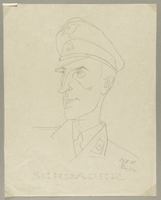
Leo Haas sketch of SS labor camp guard Schrader
Object
Ink sketch of SS officer Schrader drawn by Leo Haas, while a prisoner in Nisko forced labor camp. Leo Haas, 38, a Czech Jew and a professional artist, was arrested in 1939 in Ostrava in German occupied Czechoslovakia for being a Communist Party member. He was deported to Nisko in Poland, then shipped back to Ostrava to do forced labor. In September 1942, he was sent to Theresienstadt ghetto-labor camp, where he became part of a tight knit group of artists determined to secretly document the wretched conditions of daily life in the camp. In summer of 1944, they were accused by the Gestapo of smuggling their 'gruesome' work out of the camp. Haas was arrested and tortured. In October, he was deported to Auschwitz, and a month later, to Sachsenhausen. In February 1945, he was transported to Mauthausen and then Ebensee. He was liberated there on May 4-5 by US troops.
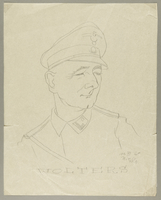
Leo Haas sketch of SS labor camp guard Wolters
Object
Ink sketch of SS officer Wolters drawn by Leo Haas, while a prisoner in Nisko forced labor camp. Leo Haas, 38, a Czech Jew and a professional artist, was arrested in 1939 in Ostrava in German occupied Czechoslovakia for being a Communist Party member. He was deported to Nisko in Poland, then shipped back to Ostrava to do forced labor. In September 1942, he was sent to Theresienstadt ghetto-labor camp, where he became part of a tight knit group of artists determined to secretly document the wretched conditions of daily life in the camp. In summer of 1944, they were accused by the Gestapo of smuggling their 'gruesome' work out of the camp. Haas was arrested and tortured. In October, he was deported to Auschwitz, and a month later, to Sachsenhausen. In February 1945, he was transported to Mauthausen and then Ebensee. He was liberated there on May 4-5 by US troops.
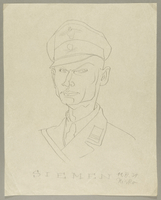
Leo Haas sketch of SS labor camp guard Siemen
Object
Ink sketch of SS officer Siemen drawn by Leo Haas, while a prisoner in Nisko forced labor camp. Leo Haas, 38, a Czech Jew and a professional artist, was arrested in 1939 in Ostrava in German occupied Czechoslovakia for being a member of the Communist Party. He was deported to Nisko in Poland, then shipped back to Ostrava to do forced labor. In September 1942, he was sent to Theresienstadt ghetto-labor camp, where he became part of a tight knit group of artists determined to secretly document the wretched conditions of daily life in the camp. In summer of 1944, they were accused by the Gestapo of smuggling their 'gruesome' work out of the camp. Haas was arrested and tortured. In October, he was deported to Auschwitz, and a month later, to Sachsenhausen. In February 1945, he was transported to Mauthausen and then Ebensee. He was liberated there on May 4-5 by US troops.
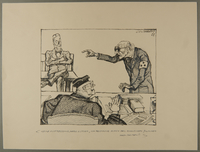
Leo Haas drawing of a blind witness identifying the guilty party at a trial
Object
Satiric drawing created by Leo Haas in 1978 with an image of an elderly blind man pointing out the guilty at a hearing. On the table near the judge is a paper marked HIAG, an aid association for former Waffen SS members, which promoted a sympathetic, revisionist history of their Nazi past. Leo Haas, 38, a Czech Jew and a professional artist, was arrested in 1939 in Ostrava in German occupied Czechoslovakia for being a Communist Party member. He was deported to Nisko labor camp in Poland, then shipped back to Ostrava to do forced labor. In September 1942, he was sent to Theresienstadt ghetto-labor camp, where he became part of a tight knit group of artists determined to secretly document the conditions of daily life in the camp. In summer of 1944, they were accused by the Gestapo of smuggling their 'gruesome' work out of the camp. Haas was arrested and tortured. In October, he was deported to Auschwitz, and a month later, to Sachsenhausen. In February 1945, he was transported to Mauthausen and then Ebensee. He was liberated there on May 4-5 by US troops. Haas moved to East Germany in 1955.
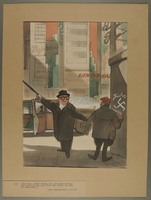
Leo Haas postwar cartoon of a wealthy man redirecting a man drawing Nazi graffitti
Object
Postwar illustration created by Leo Haas of a businessman talking to a man drawing a swastika on a building in Berlin. It was captioned: "Very gutsy, dear friend, I agree with you completely--but why don't you paint on the building of our competitor." The 1978 drawing was published in Eulenspeigel, a satirical magazine in Berlin, East Germany, where Haas was the cartoon editor. Haas, 38, a Czech Jew and a professional artist, was arrested in 1939 in Ostrava in German occupied Czechoslovakia for being a Communist. He was deported to Nisko labor camp in Poland, then shipped back to Ostrava to do forced labor. In September 1942, he was sent to Theresienstadt ghetto-labor camp, where he became part of a tight knit group of artists determined to secretly document the conditions of daily life in the camp. In summer of 1944, they were accused by the Gestapo of smuggling their 'gruesome' work out of the camp. Haas was arrested and tortured. In October, he was deported to Auschwitz, and a month later, to Sachsenhausen. In February 1945, he was transported to Mauthausen and then Ebensee. He was liberated there on May 4-5 by US troops. Haas moved to East Germany in 1955.
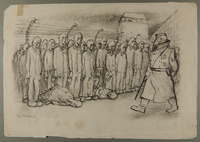
Leo Haas drawing of concentration camp inmates lined up for roll call
Object
Ink drawing created by Leo Haas depicting prisoner roll call at Mauthausen concentration camp where he was an inmate in spring 1945. For another version of this drawing see 2003.202.16. Haas, 38, a Czech Jew and a professional artist, was arrested in 1939 in Ostrava in German occupied Czechoslovakia for being a Communist Party member. He was deported to Nisko labor camp in Poland, then shipped back to Ostrava to do forced labor. In September 1942, he was sent to Theresienstadt ghetto-labor camp, where he became part of a tight knit group of artists determined to secretly document the conditions of daily life in the camp. In summer of 1944, they were accused by the Gestapo of smuggling their 'gruesome' work out of the camp. Haas was arrested and tortured. In October, he was deported to Auschwitz, and a month later, to Sachsenhausen. In February 1945, he was transported to Mauthausen and then Ebensee. He was liberated there on May 4-5 by US troops.

Portrait of a fellow concentration camp inmate by Leo Haas
Object
Portrait of Norbert Leonard drawn by Leo Haas. Both men were inmates of Mauthausen concentration camp and members of the currency counterfeiting commando run by the SS. Leo Haas, 38, a Czech Jew and a professional artist, was arrested in 1939 in Ostrava in German occupied Czechoslovakia for being a Communist Party member. He was deported to Nisko labor camp in Poland, then shipped back to Ostrava to do forced labor. In September 1942, he was sent to Theresienstadt ghetto-labor camp, where he became part of a tight knit group of artists determined to secretly document the conditions of daily life in the camp. In summer of 1944, they were accused by the Gestapo of smuggling their 'gruesome' work out of the camp. Haas was arrested and tortured. In October, he was deported to Auschwitz, and a month later, to Sachsenhausen. In February 1945, he was transported to Mauthausen and then Ebensee. He was liberated there on May 4-5 by US troops.

Leo Haas drawing of Jewish forced laborers carrying lumber
Object
Portrait of four adult male forced laborers by Leo Haas, based upon scenes he witnessed as a German prisoner in several camps. This is likely a scene from Theresienstadt ghetto-labor camp and each man is portrayed as a recognizable individual. Leo Haas, 38, a Czech Jew and a professional artist, was arrested in 1939 in Ostrava in German occupied Czechoslovakia for being a Communist Party member. He was deported to Nisko labor camp in Poland, then shipped back to Ostrava to do forced labor. In September 1942, he was sent to Theresienstadt ghetto-labor camp, where he became part of a tight knit group of artists determined to secretly document the conditions of daily life in the camp. In summer of 1944, they were accused by the Gestapo of smuggling their 'gruesome' work out of the camp. Haas was arrested and tortured. In October, he was deported to Auschwitz, and a month later, to Sachsenhausen. In February 1945, he was transported to Mauthausen and then Ebensee. He was liberated there on May 4-5 by US troops.
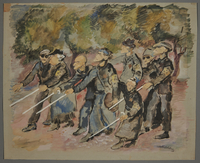
Leo Haas watercolor of blind Jewish inmates walking outdoors
Object
Watercolor by Leo Haas of a group of blind inmates with Judenstern walking outdoors. It is based on scenes he witnessed in 1942 while an inmate of Theresienstadt ghetto-labor camp. Haas was an inmate of Terezin from September 1942-October 1944. Haas, 38, a Czech Jew and a professional artist, was arrested in 1939 in Ostrava in German occupied Czechoslovakia for being a Communist. He was deported to Nisko labor camp in Poland, then shipped back to Ostrava to do forced labor. In September 1942, he was sent to Theresienstadt ghetto-labor camp, where he became part of a tight knit group of artists determined to secretly document the misery and suffering of daily life in the ghetto. They hid their work in the camp, and much was recovered postwar. In summer 1944, they were accused by the Gestapo of smuggling their 'gruesome' work out of the camp and were arrested and tortured. In October, Haas was deported to Auschwitz, and a month later, to Sachsenhausen. In February 1945, he was transported to Mauthausen and then Ebensee. He was liberated there on May 4-5 by American troops.



